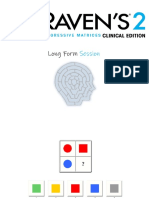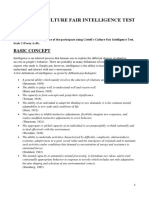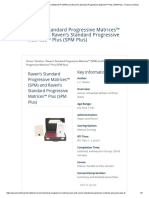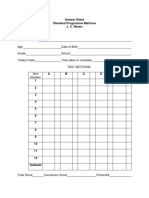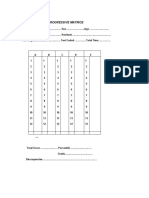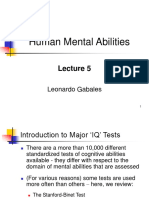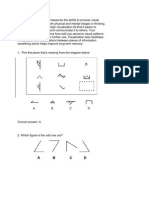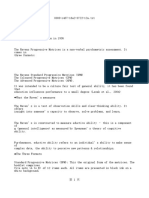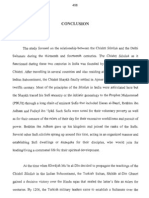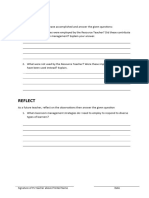Raven Final Test
Raven Final Test
Uploaded by
159242Copyright:
Available Formats
Raven Final Test
Raven Final Test
Uploaded by
159242Copyright
Available Formats
Share this document
Did you find this document useful?
Is this content inappropriate?
Copyright:
Available Formats
Raven Final Test
Raven Final Test
Uploaded by
159242Copyright:
Available Formats
Introduction Ravens Advanced Progressive Matrices (APM) published in 1947, was constructed on the prior assumption that, if Spearman's
(1923) principles were correct, it should provide a test suitable for comparing people with respect to their immediate capacities for observation and clear thinking. In advance Progressive Matrices (sets I & II) is a test of a person capacity at the time of the test to apprehend meaningless figures presented for his observation. The scale consists of 48 problems divided into two sets of. In each set the first problem is as nearly as possible self evident. The problems which follow become progressively more difficult. Until the test had been used with a wide range of adults of superior intellectual ability it was not possible to determine the best order in which to arrange the problems in the scale. Experimental work with the 1947 edition undertaken by G. A. Foulds, together with an item analysis made by A. R. Forbes & H. G. Bevans of test protocols supplied by organizations using the 1947 edition for vocational guidance or occupational selection. The 1962 edition of the APM is arranged so that it can be used equally well without a time limit. In order to asses a persons total capacity for observation and clear thinking, or with the time limit. In order to asses the efficiency of his intellectual works. It consists of two sets problems. In Set I there are 12 problems. They are designed to introduce a person to the method of working and cover all the intellectual processes needed for success in Set II. In this Set there are 36 problems. In presentation and argument they are identical with those in Set I. They only increase in difficulty more steadily and become considerably more complex. As they are arranged in order according to the frequency with which they are solved the validity of the total score does not depend upon everyone attempting all the problems in the scale before stopping. At the first attempt, no one even outstanding intellectual capacity solves them all in less than 40 minutes, while a persons interest and attention are maintained for well over an hour without boredom. Purpose of Test APM was designed to cover the widest possible range of mental ability and to be equally useful with persons of all ages weather their education, nationality or physical condition. The scale is intended to cover the whole range of intellectual development from the time a child is able to grasp the idea of finding
a missing piece to complete a pattern and to be sufficiently long to assess a person's maximum capacity to form comparisons and reason by analogy without being unduly exhausting or UN widely. History of the Advanced Progressive Matrices The development and extensive use of SPM across a wide range of subjects. Many requests came for a test which would indicate in a few minutes whether a person is intellectually dull, average, or bright. A demand also arose for a reliable test of intellectual efficiency which could be used with people of more than average intellectual capacity and which would differentiate clearly between individual people of even superior ability. The Advanced Progressive Matrices Sets i & ii or (APM) was constructed to meet these demands. It was originally drafted in 1943 for use at war office selection boar s. in 1947 a revision was prepared for general use as a non verbal test of the intellectual efficiency with which, at the time of the test, a person is able to form comparisons between figures and develop a logical method of reasoning. Over verbal tests, it has the advance that the clarity of a persons though processes are assessed independently of any educational attainments. Over performance tests, it has the advantage that, for the amount of time spent in giving the test, the information obtained is more exact and valuable. Until the test had been used with a wide range of adults of superior intellectual ability it was not possible to determine the best order in which to arrange the problems in the scale. Experimental work with the 1947 undertaken by G. A Foulds, together with an item analysis made by A. R. Forbes and H. G Bevans of test protocols supplied by organizations using the 1947 edition for vocational guidance or occupational selection, has made it possible to do this. In the 1962 edition, twelve problems which made not contribution to the score distribution for adults of more than average intellectual ability have been taken out of Set II and the remaining problems arranged in order to the frequency with which they were solved as the total score on the revised Set advanced from 0 to 36. Description The Ravens progressive matrices (APM) is a set of persons capacity at the time of the test to apprehend meaningless figures, presents for his observation, see the reaction to conceive the nature of the
figure completing each system of relations presented and by doing so develop a systematic method of reasoning. Types of Ravens Progressive Matrics There are three types of Ravens Progressive Matrics Standard Progressive Matrics Advanced Progressive Matrics Colored Progressive Matrics Standard progressive matrics This test is applied to find out the intellectual ability of individual. But it does not help the individual to find out the result of above 100 IQ. In this test we used IQ in grades. Advanced progressive matrics This test was developed to identify the intellectual superior group. It is used to measure observation, clear thinking and analytical ability. In this test we used IQ in the form of percentile. Colored progressive matrics In this test we used color background and this is applicable for 11 years of age. This test is not language based so it can apply on illiterate. Advantages of APM For vocational guidance and occupational selection, on the other hand, a "speed" or "efficiency" test is sometimes more appropriate for the former, therefore the PM un timed is more useful, before the age of 11 a child activity to form comparison and reason by analogy is often too recent and intellectual achievement and for all SPM used as an un timed test Disadvantages of APM The chief criticism is that APM does not differentiate very clearly between young children and between adults of superior intellectual capacity. It cannot be given satisfactory with a time limit and takes up to 45 minutes to complete. Psychometric Properties Reliability It is clear from APM that the test cannot used satisfactorily before the age of 11 years. At the 12 years it is reliable while with adults of more than average intellectual capacity it has the high retest Reliability of 0.91. To determine causes contributing to the low retest reliability of 0.76 obtained when the test was used with children under 11 years of age. Validity For this purpose the children of 12 years were taken from the Central Senior & Grammar schools of Country town, and the test was validated on them.
Administration and Scoring Administration
Time Limit No time limit is there in the administration of APM but sufficient time has been allotted for everyone to write down answers. Age Limit No age limit is there in APM. Material Provided A set of text books is required these can be used repeatedly. Each person required record form and pencil. Stencil keys facilitate rapid marking. Materials A set of test books is required. Each person requires a record form and pencil illustration of the record form and test, drawn twice the original size, can be used for demonstration purposes stencil keys facilitate rapid marking. Alternatively, machine score able answers form available. Accommodation The test can be given to a group of any size according to the accommodation approximately one hour must be allowed for each group. Procedure Pencils and record forms are distributed. The people to be tested asked to fill in particulars about themselves on the record form. When this has been done the test books are given out, they are asked not to open the books until everyone is ready. Supervision Mistakes occur in filling up the record form. Supervisors should see that each person has entered on his form his own solutions, to first five problems. Once a person has grasped the nature of initial problems supervisors give no further assistance in the method of reasoning. But see that each person records his own choices correctly. After about half an hour people are asked to indicate when they have finished. Scoring The subject scored her answer sheet by hand. When the series is given to the subject, the recording results enter of the form the number of each piece pointed to. If subject points to more than one piece, the piece is finally points to count the right and wrong. If one mistake is not observed until, after the last is over, the number on the extreme right only is considered whether the other number are right or wrong. If a certain proportion of cases a person elected a right figure by chance. When a person is allowed to
complete the whole of the scale, the no. of chance selection will be proportional to the no. of problems in which she falls. People who obtain for scores have a proportionality greater number of success by pure chance. To this extent the low total scores are less consistent and reliable than right scores.
Current Administration First set I can be given to assess the total capacity of person for observation and clear thinking. It is in a short practice test. Set II can be given as a time capacity test to any one who grasps the principle of Set I without difficulty and who succeed in solving more than half the problems after completing set I. It was administered in M.Sc part-I. All the class were shown Set II and asked to enter her solution on the forms. Subjects were told that the problems are exactly like those on set I, only that are more of them and they get more difficult more slowly. They were told that they must try each in turn from the beginning to the end of the book without missing any out and without turning back. They are told they can have as much time as they like, were allowed to work quickly by them without interruption and were asked to work steadily at their own speed and see how many they can get right. A little supervision is necessary to see that they were encountering their solution correctly on their form. People usually require about an hour to complete all they can do of set II. At the end subjects score is being calculated and her IQ IS (126) is obtained after matching it with the percentile (95).
BIO-DATA:
Name: ABC Age: 22years Sex: Female Education: MS.c (in process)
INTERPRETATION
Test was administered on 22 years old female college student,her score is 24 percentile score 95 and having an I.Q found to be of 125. She seems to have above average conceptualization. She seems to have the ability to perform at high standards.She has strong imaginative power. She appears to have potentials to excel in rapid decision-making and in situation where part whole relationships must be perceived.Her I.Q depicts that she has intellectual abilities such as overall she has good perceptual organization and ability to discriminate and find similarities between abstract things.
References Anastasia Anne (1990). Psychological Testing. New York: Maxwell Macmillan Publishing Company. Raven, Court. J, (1977) Manual for Raven Progressive Matrices and Vocabulary ScalesAdvance Progressive Matrices Set I & Set II. London. H. K. Lewis & Co. Ltd
You might also like
- Ravens Advanced Progressive Matrices Practice Book IQ Test Previewinjaplus - IrDocument10 pagesRavens Advanced Progressive Matrices Practice Book IQ Test Previewinjaplus - IrFriend Katsumata50% (2)
- APM (Advanced Progressive Matrices)Document28 pagesAPM (Advanced Progressive Matrices)hafsa11152% (21)
- Sample Intelligence Test Items: VerbalDocument3 pagesSample Intelligence Test Items: Verbalhebalove2011614683% (6)
- Administration of Wais - IvDocument11 pagesAdministration of Wais - Ivrupal arora75% (4)
- Raven S Advanced Progressive MatrixDocument125 pagesRaven S Advanced Progressive MatrixSuomi Finlandia100% (1)
- Ravens Progressive MatricesDocument16 pagesRavens Progressive Matricesabc123-189% (74)
- Raven 2 Progressive MatricesDocument50 pagesRaven 2 Progressive Matriceshhhhha90% (10)
- Cattel's Culture Fair Intelligence TestDocument20 pagesCattel's Culture Fair Intelligence TestBrinda Zasha Taparia79% (19)
- IQ Test Raven S Advanced Progressive Matrices PDFDocument126 pagesIQ Test Raven S Advanced Progressive Matrices PDFflorinpre92% (13)
- Cattelx27s Culture Fair Intelligence Test PDF FreeDocument20 pagesCattelx27s Culture Fair Intelligence Test PDF FreeWisnu100% (1)
- Ravens APM Item Banked Manual Part 1Document46 pagesRavens APM Item Banked Manual Part 1CH KarimNo ratings yet
- 4 Raven's Standard Progressive Matrices™ (SPM)Document1 page4 Raven's Standard Progressive Matrices™ (SPM)VINEET GAIROLA0% (1)
- WISC-IV - Conceptual and Interpretive GuideDocument4 pagesWISC-IV - Conceptual and Interpretive Guideamnessia100% (1)
- IQ Test - Raven's Progressive MatricesDocument3 pagesIQ Test - Raven's Progressive MatricesKumarAtul45% (11)
- Ravens SPM Answer SheetDocument1 pageRavens SPM Answer SheetvaluatNo ratings yet
- Raven's Apm International Technical ManualDocument50 pagesRaven's Apm International Technical ManualArscent Piliin70% (10)
- The Raven's 2 Progressive Matrices Tests and Manual Pearson, 2018Document26 pagesThe Raven's 2 Progressive Matrices Tests and Manual Pearson, 2018Remik BuczekNo ratings yet
- Raven's Progressive Matrice Answer SheetDocument1 pageRaven's Progressive Matrice Answer Sheetjavariakhan40% (5)
- Raven's Standard Progressive Matrices (SPM) : June, 2012Document5 pagesRaven's Standard Progressive Matrices (SPM) : June, 2012god_26No ratings yet
- Stanford - Binet Intelligence Scale: Fifth Edition: Condag, PagaranDocument24 pagesStanford - Binet Intelligence Scale: Fifth Edition: Condag, PagaranUnica Condag50% (2)
- About The Raven's 2Document9 pagesAbout The Raven's 2Remik Buczek100% (1)
- WISC IV Handout PDFDocument121 pagesWISC IV Handout PDFvaluat100% (1)
- Wechsler Adult Performance Intelligence ScaleDocument19 pagesWechsler Adult Performance Intelligence Scalepriyanshi khandelwal100% (2)
- Raven's Progressive MatricesDocument4 pagesRaven's Progressive MatricesPsic Beatriz Tejeda VNo ratings yet
- Picture Arrengement WaisDocument60 pagesPicture Arrengement WaisAbshar ParamaNo ratings yet
- Culture Fair Intelligence TestDocument2 pagesCulture Fair Intelligence TestMelanie Christine Soriano Pascua80% (5)
- Advance Progresive Matrices PDFDocument14 pagesAdvance Progresive Matrices PDFmonumenNo ratings yet
- Raven's Progressive MatricesDocument12 pagesRaven's Progressive MatricesLa Osana60% (5)
- IntelligenceDocument31 pagesIntelligenceKhalid Saif Jan100% (1)
- Ravens Progressive MatricesDocument2 pagesRavens Progressive MatricesAZGH HOSPITAL /Cyberdyne PhilippinesNo ratings yet
- Raven MatricesDocument26 pagesRaven Matricesbogdan50% (2)
- RAND - Raven's Progressive Matrices TestDocument37 pagesRAND - Raven's Progressive Matrices Testk10924100% (1)
- Wechsler Adult Intelligence Scale-Revised: by Faryal FarooqDocument44 pagesWechsler Adult Intelligence Scale-Revised: by Faryal FarooqMariyya Muzaffar Janjua100% (2)
- Leiter-3 Admin SubscalesDocument13 pagesLeiter-3 Admin SubscalesPsy Ramadan El HaweyNo ratings yet
- Raven's Advanced Progressive Matrices Test With Iconic Visual RepresentationsDocument6 pagesRaven's Advanced Progressive Matrices Test With Iconic Visual Representationscris0% (1)
- Condensed Guide for the Stanford Revision of the Binet-Simon Intelligence TestsFrom EverandCondensed Guide for the Stanford Revision of the Binet-Simon Intelligence TestsNo ratings yet
- 9.social Learning TheoryDocument7 pages9.social Learning TheorySaba IqbalNo ratings yet
- RSPM Manual RetypedDocument8 pagesRSPM Manual RetypedTanjima Rahman100% (1)
- Ravens Progressive Matrices PDFDocument6 pagesRavens Progressive Matrices PDFpritiNo ratings yet
- Raven's Progressive Matrices PDFDocument4 pagesRaven's Progressive Matrices PDFFerrer Benedick57% (7)
- Raven's Progressive MatricesDocument13 pagesRaven's Progressive MatricesDarkskull Tayyab100% (2)
- Raven's Progressive MatricesDocument4 pagesRaven's Progressive MatricesAnonymous ImPC4e33% (3)
- Binet VS Wechsler Intelligence ScalesDocument40 pagesBinet VS Wechsler Intelligence ScalesSaima GhazalNo ratings yet
- Information On Ravens Progressive Matrices TestDocument10 pagesInformation On Ravens Progressive Matrices TestMousumi LahiriNo ratings yet
- WAISDocument42 pagesWAISAsima MunawarNo ratings yet
- Raven Progressive MatricesDocument2 pagesRaven Progressive MatricesJomay Pardillo75% (4)
- Wppsi Iiimay 2012Document5 pagesWppsi Iiimay 2012Cherilyn SaagundoNo ratings yet
- Ravens Standard Progressive Matrices New PDFDocument12 pagesRavens Standard Progressive Matrices New PDFPlumfloral100% (2)
- Raven TestDocument9 pagesRaven Testhilmiasyraf100% (4)
- Administration and Scoring of Verbal Components of WaisDocument13 pagesAdministration and Scoring of Verbal Components of WaisAli Haider50% (2)
- Ravens Progressive Matrices EditedDocument62 pagesRavens Progressive Matrices EditedCannery OlezaNo ratings yet
- Culture Fair Intelligence TestDocument2 pagesCulture Fair Intelligence TestdocshNo ratings yet
- Psychological Assessment 2Document12 pagesPsychological Assessment 2Faryal HassanNo ratings yet
- Bhatia Battery TestDocument5 pagesBhatia Battery TestAkshita Singh100% (1)
- SPM 2 3Document7 pagesSPM 2 3pinkykuku12No ratings yet
- RSPMDocument14 pagesRSPMEmaan AtifNo ratings yet
- Exp2 PsylDocument8 pagesExp2 Psylsayed.mahmud7No ratings yet
- Standard Progressive MatricesDocument7 pagesStandard Progressive Matricesmahek4508No ratings yet
- Non-Verbal Test of Intelligence (Nvti)Document5 pagesNon-Verbal Test of Intelligence (Nvti)Shruti Shrivastava100% (1)
- WAIS, RPM, GATB (Unit - 1) IntelligenceDocument5 pagesWAIS, RPM, GATB (Unit - 1) Intelligenceshivamkumar8650160880No ratings yet
- JokesDocument2 pagesJokes159242No ratings yet
- Hazrat Salman FarsiDocument2 pagesHazrat Salman Farsi159242No ratings yet
- Chisti Silsilah 5Document64 pagesChisti Silsilah 5159242100% (1)
- The Easy Dictionary 4 QuraanDocument171 pagesThe Easy Dictionary 4 Quraanossha100% (1)
- The 68 Blemishes of The NafsDocument3 pagesThe 68 Blemishes of The Nafs159242No ratings yet
- The Effect of Teachers Teaching Style and Students MotivationDocument7 pagesThe Effect of Teachers Teaching Style and Students MotivationKaye Amor Bolivar BillanesNo ratings yet
- Statistics and Probability - Exploring DataDocument18 pagesStatistics and Probability - Exploring Datajoy encarnacionNo ratings yet
- Guia de Trabajo (Question Words, Object Pronouns and Possessive Pronouns)Document5 pagesGuia de Trabajo (Question Words, Object Pronouns and Possessive Pronouns)CHRISTIAN LEONARDO GUERRERO LEONNo ratings yet
- BSBHRM521 Student Assessment TasksDocument32 pagesBSBHRM521 Student Assessment TasksKaneez BatoolNo ratings yet
- Curriculum Vitae English DateDocument5 pagesCurriculum Vitae English Datezpxjybifg100% (2)
- Project GuidelinesDocument11 pagesProject GuidelinesPreet kaur sardarniNo ratings yet
- Proiect Didactic 2Document4 pagesProiect Didactic 2Crăciun AlinaNo ratings yet
- 5 Leadership TheoriesDocument2 pages5 Leadership TheoriesJaspher Loís DoyolaNo ratings yet
- Q3_WS_Mathematics 4_Lesson 8_Week 8Document6 pagesQ3_WS_Mathematics 4_Lesson 8_Week 8kristineanamaedbusabosNo ratings yet
- DRR PLAN 2021-2022 NewDocument2 pagesDRR PLAN 2021-2022 NewJOEL DAENNo ratings yet
- Types of ResearchDocument5 pagesTypes of ResearchMuhammad Mohkam Ud Din0% (1)
- BibliographyDocument2 pagesBibliographyMarinescu RamonaNo ratings yet
- s3 mathDocument4 pagess3 mathhouselantaNo ratings yet
- Cost FunctionDocument21 pagesCost FunctionSwapnil BeraNo ratings yet
- Herbert Simon ContributionDocument10 pagesHerbert Simon Contributionarhamenterprises5401No ratings yet
- I. Objectives: Teaching WeekDocument8 pagesI. Objectives: Teaching WeekBarbara PosoNo ratings yet
- Lec 00 Highway Engineering - Opening and SyllabusDocument10 pagesLec 00 Highway Engineering - Opening and SyllabusDr Firas Asad100% (2)
- Semi Structured InterviewsDocument11 pagesSemi Structured InterviewsTeacher Kerly PabónNo ratings yet
- Listening + Taking Notes + SpeakingDocument2 pagesListening + Taking Notes + SpeakingHuy NguyễnNo ratings yet
- Rubrics - Lab Course Work Assessment - August 2023 - Lab RubricsDocument1 pageRubrics - Lab Course Work Assessment - August 2023 - Lab RubricsUtsavNo ratings yet
- Episode 7 FS1Document4 pagesEpisode 7 FS1LM AgustinNo ratings yet
- Direct Frequency Domain Computation of Transmission Line Transients Due To Switching OperationsDocument7 pagesDirect Frequency Domain Computation of Transmission Line Transients Due To Switching OperationsdanluscribNo ratings yet
- Advanced - Composite - Materials - 2024 2 1 9 47 23Document2 pagesAdvanced - Composite - Materials - 2024 2 1 9 47 23Charan RavulaNo ratings yet
- Soc Res Revised EverythingDocument11 pagesSoc Res Revised EverythingAbi VillamorNo ratings yet
- Curriculum VitaeDocument3 pagesCurriculum Vitaeapi-3855534No ratings yet
- Module 1 Prepare Egg DishesDocument7 pagesModule 1 Prepare Egg DishesCynthia JeresanoNo ratings yet
- Homer the PoetDocument10 pagesHomer the Poetkaylieowens87No ratings yet
- BCA Math-108 QuespaperDocument4 pagesBCA Math-108 Quespaperpriyanshichhikara8No ratings yet
- Balane DLP TTPDocument4 pagesBalane DLP TTPgabriel.balane27No ratings yet






